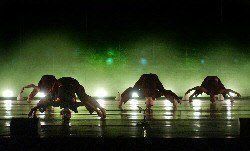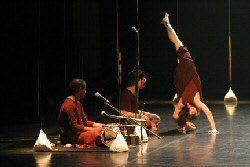Over the last twelve months or so the Theatre Royal's contemporary dance programming has been almost exemplary: in 2004 we had Bill T Jones, The Dance Theatre of Harlem, NDT2, Matthew Bourne's Play Without Words and the Rambert Dance Company. So far this year there's been the Australian Dance Theatre's Birdbrain and Matthew Bourne returns with Highland Fling in April. There are, obviously, a few names we'd like to add to the list, but there's no doubt that the theatre serves contemporary dance fans well.
And tonight we had Akram Khan's ma.
It is tempting to refer to ma as a fusion of Indian kathak (the classical dance style of Northern India) and western contemporary dance, but Khan, an Asian born in the UK, prefers to call it "confusion", a word which, with its base meaning of "fusion with" and its normal use, is perhaps a lot more appropriate. From kathak he takes the speed, fast spins, complex angular arm movements, the interplay between the dancers and on-stage musicians, and narrative. At one point two dancers, one behind the other and lit from the stage floor, cast a huge shadow of the four-armed goddess Kali on the back wall, the goddess who represents naked nature, the ultimate reality.
There are six dancers, including Khan, three musicians (B.C. Manjunath - percussion, Natalie Rozario - cello, and Lisa Mallet - flute), and one Sufi vocalist (Faheen Mazhar).
The piece opens with a chant in darkness and then a tight spotlight gradually brightens to reveal Mazhar, singing suspended upside down. Another spot brightens on a solitary female dancer at the front of the stage. She speaks a single syllable, "Tak" (sky) and another chant begins, mingling "tak" and "thum" (earth). Suddenly brilliant light all around the stage snaps on, simultaneouly dazzling and shocking the audience. They were audible gasps!
These motifs reappear throughout. The upside down motif, for example, appears when one of the dancers tells a story to the audience (interrupted constantly by another), and both are upside down, supported on one leg and one hand, and on numerous occasions the dancers (singly, in pairs or altogether) support themselves with legs and head on the ground while their arms spread like wings. It is rather reminiscent of insects: indeed, many of the movements have an insect quality about them.
And it is the female dancers who take the lead through most of the piece, emphasising the ma/mother/earth element.
The lighting, designed by Mikki Kunttu, is fascinating. No part of the piece, except for the curtain call, is lit from front of house: all light comes from behind the pros arch. Floor lighting is not uncommon and at one or two points there is not even sidelight: everything comes from directly above. The interesting interplay of shadows has a subtle unsettling effect, which reflects the mixture of dance styles and the music, which mixes traditional Sufi singing with a very contemporary score by Riccardo Nova.
ma is not an easy piece, but it is endlessly fascinating and reveals further depth and complexity long after the curtain has come down. It is superbly performed and one cannot fail to be impressed by the whole company. The audience - far smaller, unfortunately, than the quality of the show warrants but with a strong student element - was very enthusistic (and vocal) in its appreciation.
The international tour continues into 2006.

